Human Resource Management Report: HSBC Bank Analysis
VerifiedAdded on 2020/06/04
|12
|3356
|210
Report
AI Summary
This report provides a comprehensive analysis of Human Resource Management (HRM) within the context of HSBC Bank. It begins by defining HRM and its core functions, emphasizing its importance in organizational success. The report then delves into the purpose of HRM, highlighting its role in increasing productivity and fostering positive employee relationships. The strengths and weaknesses of internal and external recruitment methods are evaluated, followed by an examination of the benefits of various HRM practices for both employees and employers, illustrated with examples from HSBC. The report further assesses the effectiveness of different HRM practices, such as payment and rewards, collaboration, and flexible working options. The significance of employee relations in decision-making is explored, emphasizing the importance of communication and employee loyalty. Finally, the report concludes with an overview of employment legislation's impact on decision-making, underscoring the need for HR managers to adhere to all relevant laws and regulations.
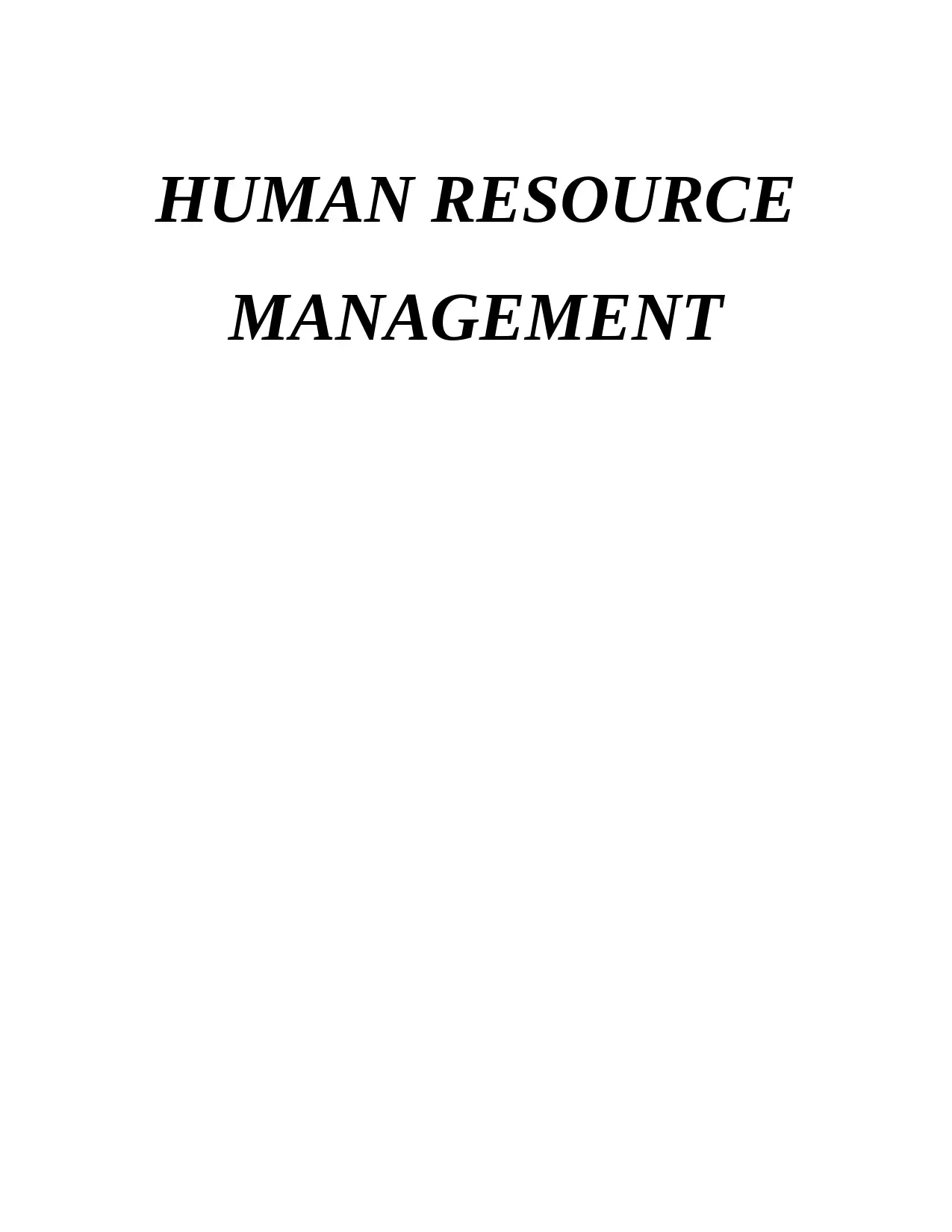
HUMAN RESOURCE
MANAGEMENT
MANAGEMENT
Paraphrase This Document
Need a fresh take? Get an instant paraphrase of this document with our AI Paraphraser

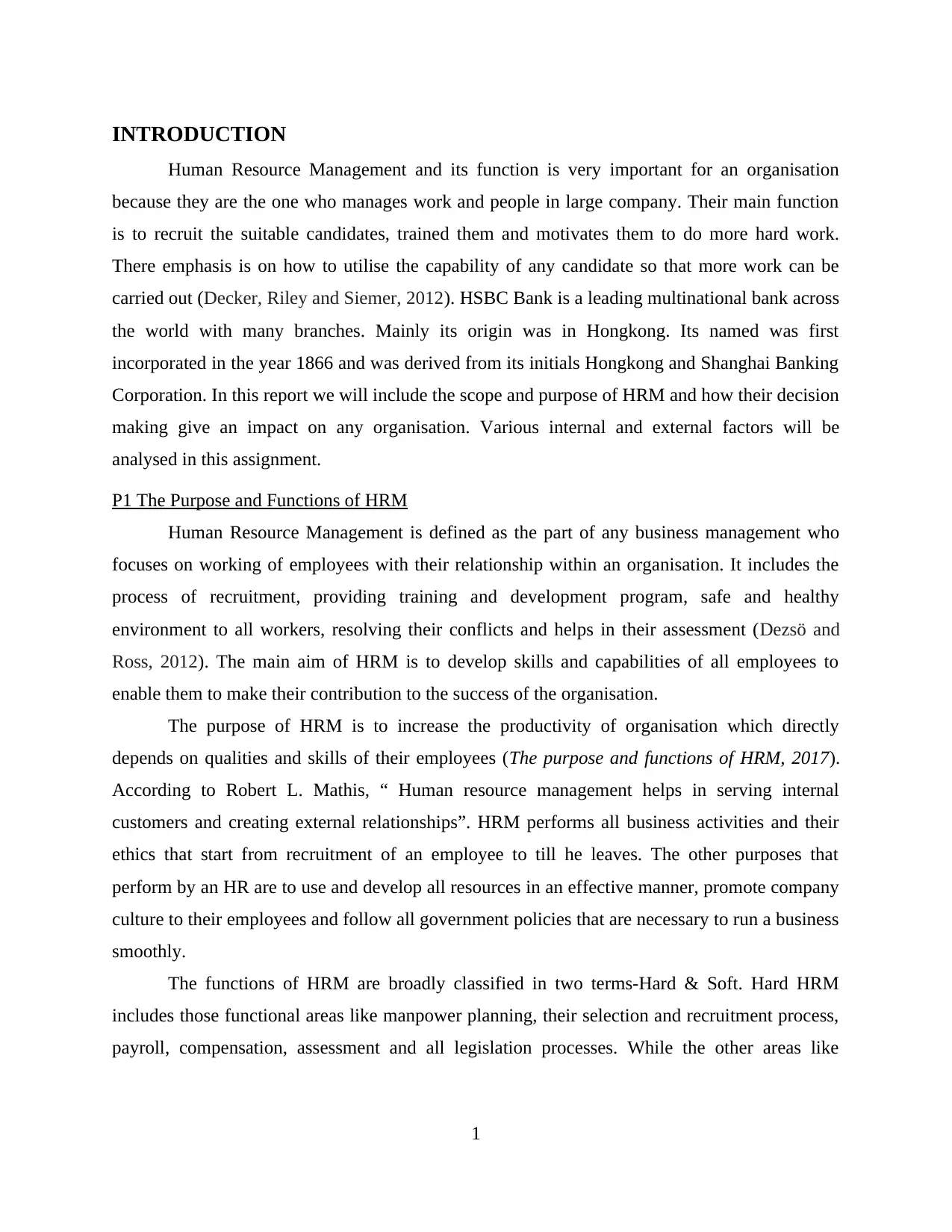
INTRODUCTION
Human Resource Management and its function is very important for an organisation
because they are the one who manages work and people in large company. Their main function
is to recruit the suitable candidates, trained them and motivates them to do more hard work.
There emphasis is on how to utilise the capability of any candidate so that more work can be
carried out (Decker, Riley and Siemer, 2012). HSBC Bank is a leading multinational bank across
the world with many branches. Mainly its origin was in Hongkong. Its named was first
incorporated in the year 1866 and was derived from its initials Hongkong and Shanghai Banking
Corporation. In this report we will include the scope and purpose of HRM and how their decision
making give an impact on any organisation. Various internal and external factors will be
analysed in this assignment.
P1 The Purpose and Functions of HRM
Human Resource Management is defined as the part of any business management who
focuses on working of employees with their relationship within an organisation. It includes the
process of recruitment, providing training and development program, safe and healthy
environment to all workers, resolving their conflicts and helps in their assessment (Dezsö and
Ross, 2012). The main aim of HRM is to develop skills and capabilities of all employees to
enable them to make their contribution to the success of the organisation.
The purpose of HRM is to increase the productivity of organisation which directly
depends on qualities and skills of their employees (The purpose and functions of HRM, 2017).
According to Robert L. Mathis, “ Human resource management helps in serving internal
customers and creating external relationships”. HRM performs all business activities and their
ethics that start from recruitment of an employee to till he leaves. The other purposes that
perform by an HR are to use and develop all resources in an effective manner, promote company
culture to their employees and follow all government policies that are necessary to run a business
smoothly.
The functions of HRM are broadly classified in two terms-Hard & Soft. Hard HRM
includes those functional areas like manpower planning, their selection and recruitment process,
payroll, compensation, assessment and all legislation processes. While the other areas like
1
Human Resource Management and its function is very important for an organisation
because they are the one who manages work and people in large company. Their main function
is to recruit the suitable candidates, trained them and motivates them to do more hard work.
There emphasis is on how to utilise the capability of any candidate so that more work can be
carried out (Decker, Riley and Siemer, 2012). HSBC Bank is a leading multinational bank across
the world with many branches. Mainly its origin was in Hongkong. Its named was first
incorporated in the year 1866 and was derived from its initials Hongkong and Shanghai Banking
Corporation. In this report we will include the scope and purpose of HRM and how their decision
making give an impact on any organisation. Various internal and external factors will be
analysed in this assignment.
P1 The Purpose and Functions of HRM
Human Resource Management is defined as the part of any business management who
focuses on working of employees with their relationship within an organisation. It includes the
process of recruitment, providing training and development program, safe and healthy
environment to all workers, resolving their conflicts and helps in their assessment (Dezsö and
Ross, 2012). The main aim of HRM is to develop skills and capabilities of all employees to
enable them to make their contribution to the success of the organisation.
The purpose of HRM is to increase the productivity of organisation which directly
depends on qualities and skills of their employees (The purpose and functions of HRM, 2017).
According to Robert L. Mathis, “ Human resource management helps in serving internal
customers and creating external relationships”. HRM performs all business activities and their
ethics that start from recruitment of an employee to till he leaves. The other purposes that
perform by an HR are to use and develop all resources in an effective manner, promote company
culture to their employees and follow all government policies that are necessary to run a business
smoothly.
The functions of HRM are broadly classified in two terms-Hard & Soft. Hard HRM
includes those functional areas like manpower planning, their selection and recruitment process,
payroll, compensation, assessment and all legislation processes. While the other areas like
1
⊘ This is a preview!⊘
Do you want full access?
Subscribe today to unlock all pages.

Trusted by 1+ million students worldwide
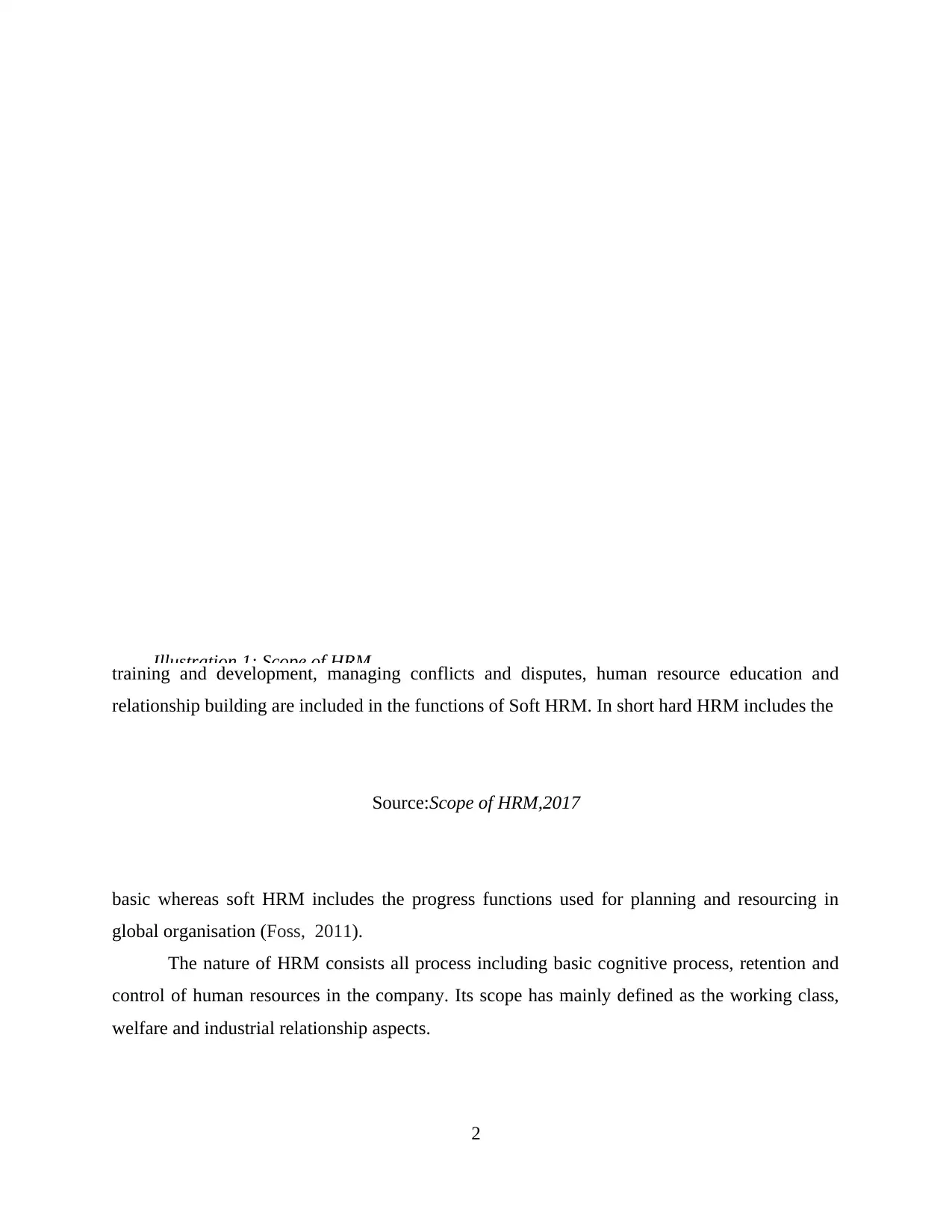
training and development, managing conflicts and disputes, human resource education and
relationship building are included in the functions of Soft HRM. In short hard HRM includes the
Source:Scope of HRM,2017
basic whereas soft HRM includes the progress functions used for planning and resourcing in
global organisation (Foss, 2011).
The nature of HRM consists all process including basic cognitive process, retention and
control of human resources in the company. Its scope has mainly defined as the working class,
welfare and industrial relationship aspects.
2
Illustration 1: Scope of HRM
relationship building are included in the functions of Soft HRM. In short hard HRM includes the
Source:Scope of HRM,2017
basic whereas soft HRM includes the progress functions used for planning and resourcing in
global organisation (Foss, 2011).
The nature of HRM consists all process including basic cognitive process, retention and
control of human resources in the company. Its scope has mainly defined as the working class,
welfare and industrial relationship aspects.
2
Illustration 1: Scope of HRM
Paraphrase This Document
Need a fresh take? Get an instant paraphrase of this document with our AI Paraphraser
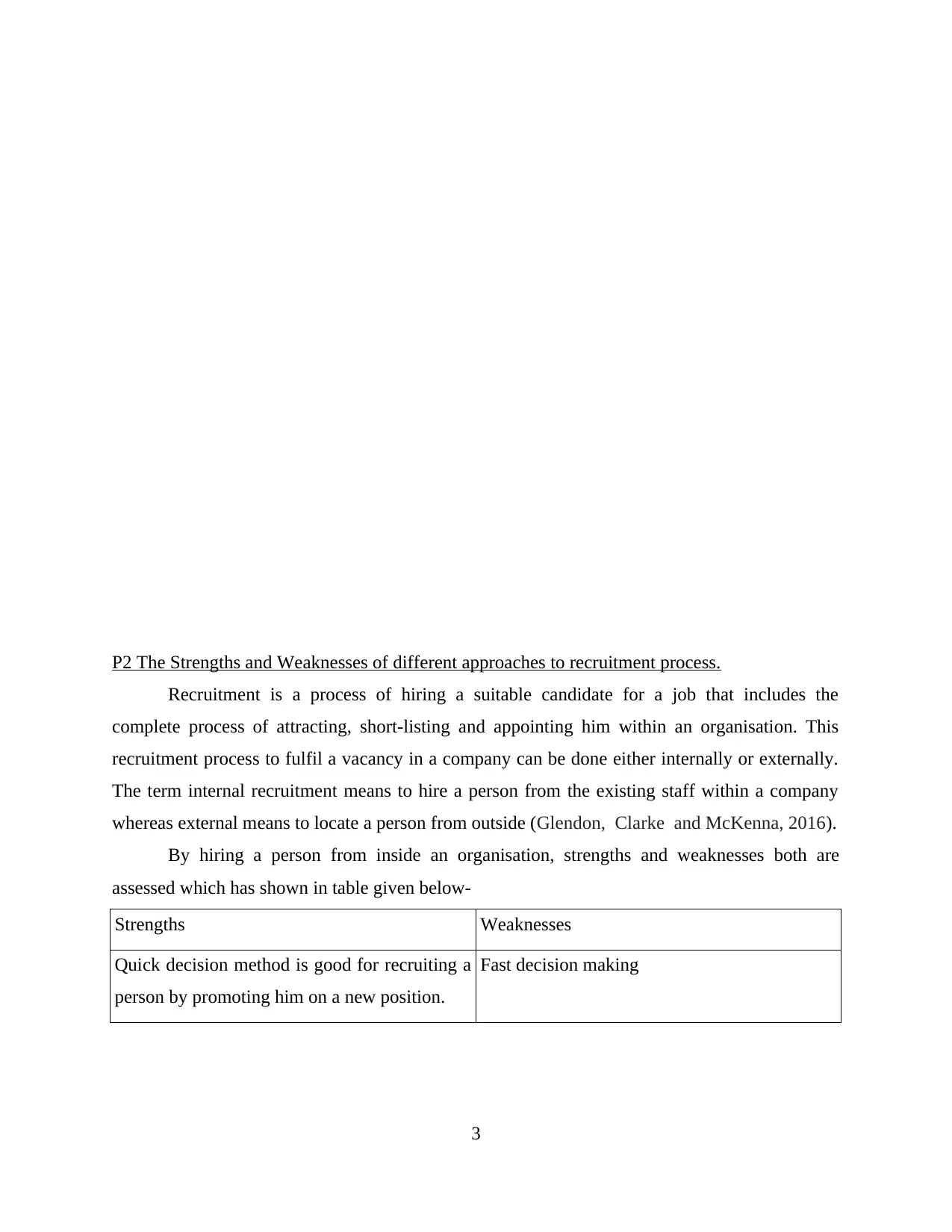
P2 The Strengths and Weaknesses of different approaches to recruitment process.
Recruitment is a process of hiring a suitable candidate for a job that includes the
complete process of attracting, short-listing and appointing him within an organisation. This
recruitment process to fulfil a vacancy in a company can be done either internally or externally.
The term internal recruitment means to hire a person from the existing staff within a company
whereas external means to locate a person from outside (Glendon, Clarke and McKenna, 2016).
By hiring a person from inside an organisation, strengths and weaknesses both are
assessed which has shown in table given below-
Strengths Weaknesses
Quick decision method is good for recruiting a
person by promoting him on a new position.
Fast decision making
3
Recruitment is a process of hiring a suitable candidate for a job that includes the
complete process of attracting, short-listing and appointing him within an organisation. This
recruitment process to fulfil a vacancy in a company can be done either internally or externally.
The term internal recruitment means to hire a person from the existing staff within a company
whereas external means to locate a person from outside (Glendon, Clarke and McKenna, 2016).
By hiring a person from inside an organisation, strengths and weaknesses both are
assessed which has shown in table given below-
Strengths Weaknesses
Quick decision method is good for recruiting a
person by promoting him on a new position.
Fast decision making
3
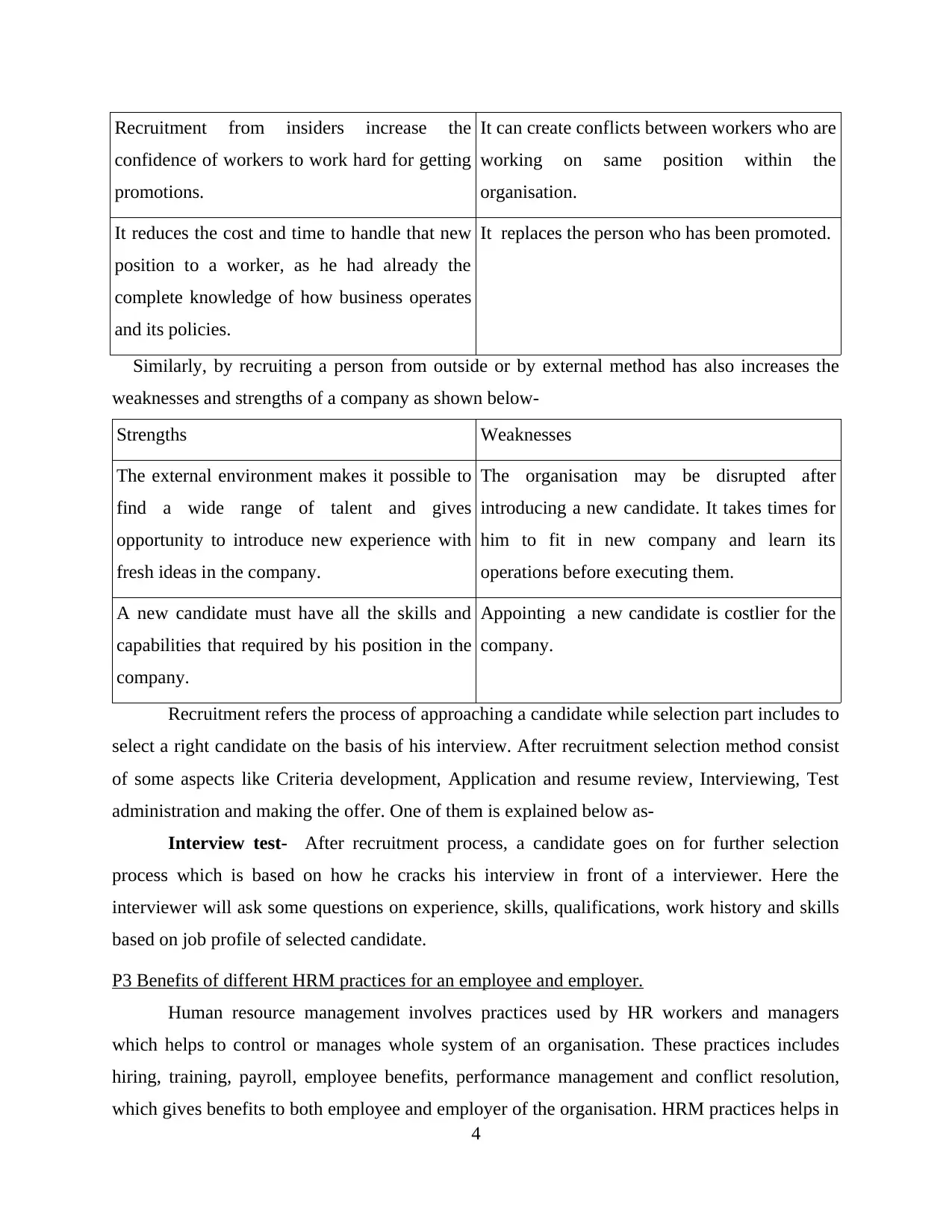
Recruitment from insiders increase the
confidence of workers to work hard for getting
promotions.
It can create conflicts between workers who are
working on same position within the
organisation.
It reduces the cost and time to handle that new
position to a worker, as he had already the
complete knowledge of how business operates
and its policies.
It replaces the person who has been promoted.
Similarly, by recruiting a person from outside or by external method has also increases the
weaknesses and strengths of a company as shown below-
Strengths Weaknesses
The external environment makes it possible to
find a wide range of talent and gives
opportunity to introduce new experience with
fresh ideas in the company.
The organisation may be disrupted after
introducing a new candidate. It takes times for
him to fit in new company and learn its
operations before executing them.
A new candidate must have all the skills and
capabilities that required by his position in the
company.
Appointing a new candidate is costlier for the
company.
Recruitment refers the process of approaching a candidate while selection part includes to
select a right candidate on the basis of his interview. After recruitment selection method consist
of some aspects like Criteria development, Application and resume review, Interviewing, Test
administration and making the offer. One of them is explained below as-
Interview test- After recruitment process, a candidate goes on for further selection
process which is based on how he cracks his interview in front of a interviewer. Here the
interviewer will ask some questions on experience, skills, qualifications, work history and skills
based on job profile of selected candidate.
P3 Benefits of different HRM practices for an employee and employer.
Human resource management involves practices used by HR workers and managers
which helps to control or manages whole system of an organisation. These practices includes
hiring, training, payroll, employee benefits, performance management and conflict resolution,
which gives benefits to both employee and employer of the organisation. HRM practices helps in
4
confidence of workers to work hard for getting
promotions.
It can create conflicts between workers who are
working on same position within the
organisation.
It reduces the cost and time to handle that new
position to a worker, as he had already the
complete knowledge of how business operates
and its policies.
It replaces the person who has been promoted.
Similarly, by recruiting a person from outside or by external method has also increases the
weaknesses and strengths of a company as shown below-
Strengths Weaknesses
The external environment makes it possible to
find a wide range of talent and gives
opportunity to introduce new experience with
fresh ideas in the company.
The organisation may be disrupted after
introducing a new candidate. It takes times for
him to fit in new company and learn its
operations before executing them.
A new candidate must have all the skills and
capabilities that required by his position in the
company.
Appointing a new candidate is costlier for the
company.
Recruitment refers the process of approaching a candidate while selection part includes to
select a right candidate on the basis of his interview. After recruitment selection method consist
of some aspects like Criteria development, Application and resume review, Interviewing, Test
administration and making the offer. One of them is explained below as-
Interview test- After recruitment process, a candidate goes on for further selection
process which is based on how he cracks his interview in front of a interviewer. Here the
interviewer will ask some questions on experience, skills, qualifications, work history and skills
based on job profile of selected candidate.
P3 Benefits of different HRM practices for an employee and employer.
Human resource management involves practices used by HR workers and managers
which helps to control or manages whole system of an organisation. These practices includes
hiring, training, payroll, employee benefits, performance management and conflict resolution,
which gives benefits to both employee and employer of the organisation. HRM practices helps in
4
⊘ This is a preview!⊘
Do you want full access?
Subscribe today to unlock all pages.

Trusted by 1+ million students worldwide
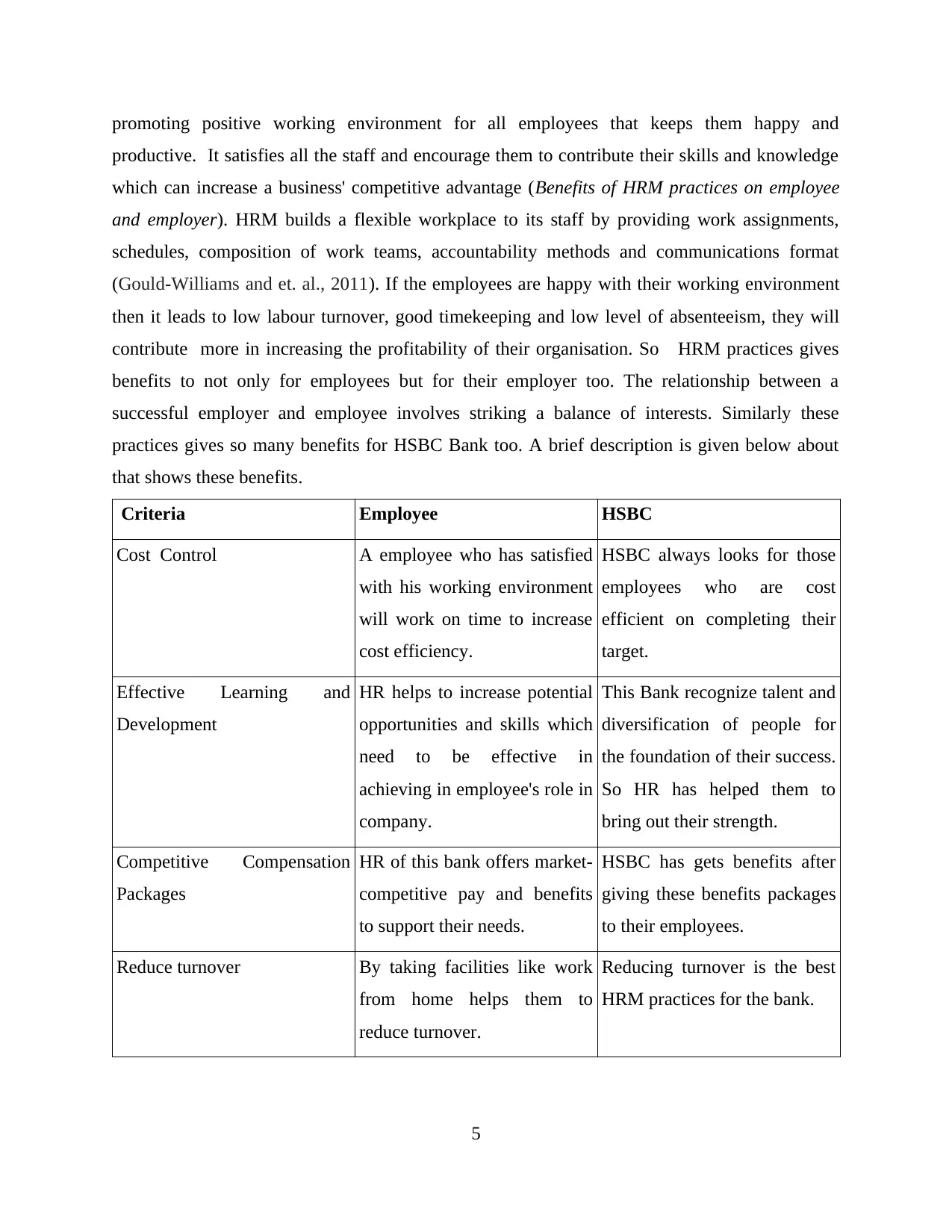
promoting positive working environment for all employees that keeps them happy and
productive. It satisfies all the staff and encourage them to contribute their skills and knowledge
which can increase a business' competitive advantage (Benefits of HRM practices on employee
and employer). HRM builds a flexible workplace to its staff by providing work assignments,
schedules, composition of work teams, accountability methods and communications format
(Gould-Williams and et. al., 2011). If the employees are happy with their working environment
then it leads to low labour turnover, good timekeeping and low level of absenteeism, they will
contribute more in increasing the profitability of their organisation. So HRM practices gives
benefits to not only for employees but for their employer too. The relationship between a
successful employer and employee involves striking a balance of interests. Similarly these
practices gives so many benefits for HSBC Bank too. A brief description is given below about
that shows these benefits.
Criteria Employee HSBC
Cost Control A employee who has satisfied
with his working environment
will work on time to increase
cost efficiency.
HSBC always looks for those
employees who are cost
efficient on completing their
target.
Effective Learning and
Development
HR helps to increase potential
opportunities and skills which
need to be effective in
achieving in employee's role in
company.
This Bank recognize talent and
diversification of people for
the foundation of their success.
So HR has helped them to
bring out their strength.
Competitive Compensation
Packages
HR of this bank offers market-
competitive pay and benefits
to support their needs.
HSBC has gets benefits after
giving these benefits packages
to their employees.
Reduce turnover By taking facilities like work
from home helps them to
reduce turnover.
Reducing turnover is the best
HRM practices for the bank.
5
productive. It satisfies all the staff and encourage them to contribute their skills and knowledge
which can increase a business' competitive advantage (Benefits of HRM practices on employee
and employer). HRM builds a flexible workplace to its staff by providing work assignments,
schedules, composition of work teams, accountability methods and communications format
(Gould-Williams and et. al., 2011). If the employees are happy with their working environment
then it leads to low labour turnover, good timekeeping and low level of absenteeism, they will
contribute more in increasing the profitability of their organisation. So HRM practices gives
benefits to not only for employees but for their employer too. The relationship between a
successful employer and employee involves striking a balance of interests. Similarly these
practices gives so many benefits for HSBC Bank too. A brief description is given below about
that shows these benefits.
Criteria Employee HSBC
Cost Control A employee who has satisfied
with his working environment
will work on time to increase
cost efficiency.
HSBC always looks for those
employees who are cost
efficient on completing their
target.
Effective Learning and
Development
HR helps to increase potential
opportunities and skills which
need to be effective in
achieving in employee's role in
company.
This Bank recognize talent and
diversification of people for
the foundation of their success.
So HR has helped them to
bring out their strength.
Competitive Compensation
Packages
HR of this bank offers market-
competitive pay and benefits
to support their needs.
HSBC has gets benefits after
giving these benefits packages
to their employees.
Reduce turnover By taking facilities like work
from home helps them to
reduce turnover.
Reducing turnover is the best
HRM practices for the bank.
5
Paraphrase This Document
Need a fresh take? Get an instant paraphrase of this document with our AI Paraphraser
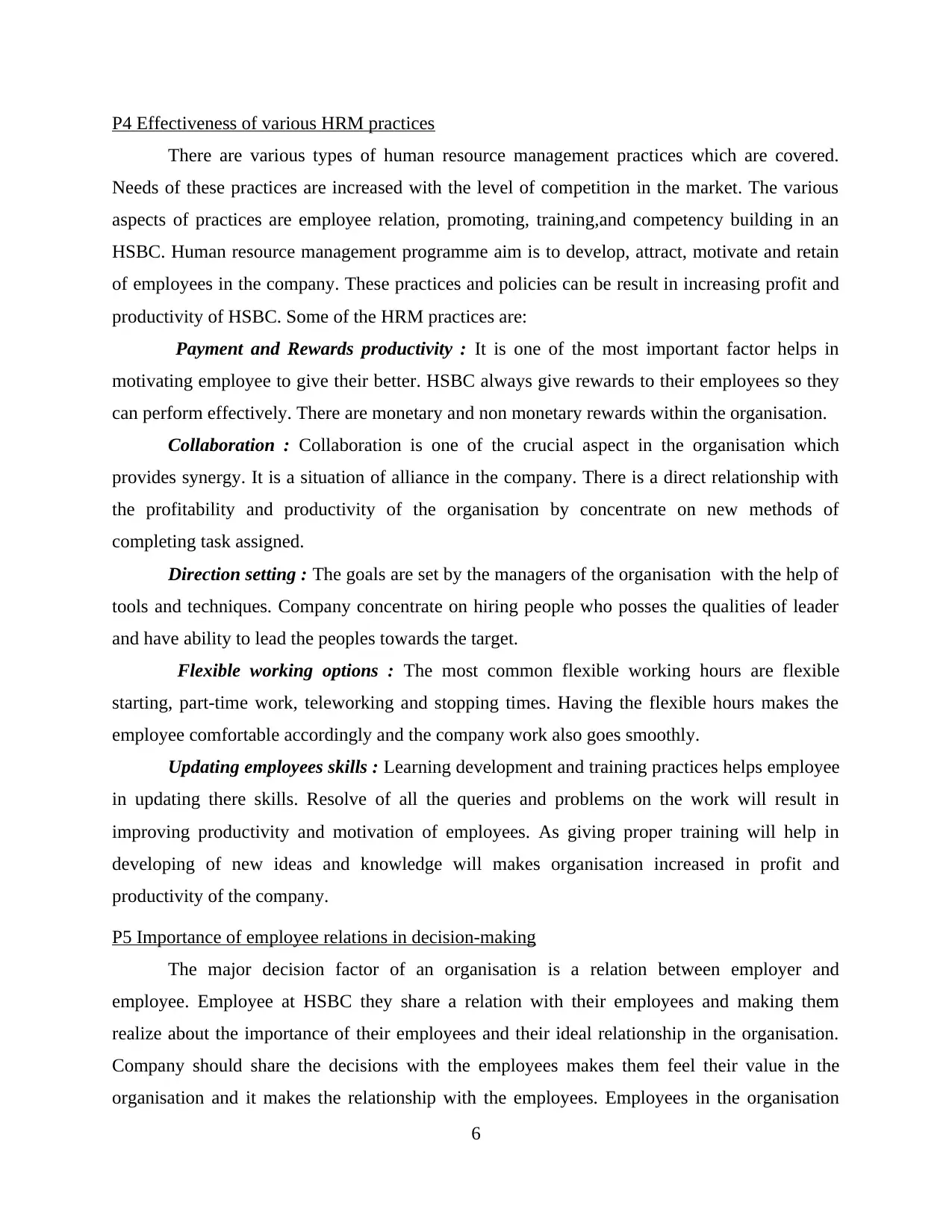
P4 Effectiveness of various HRM practices
There are various types of human resource management practices which are covered.
Needs of these practices are increased with the level of competition in the market. The various
aspects of practices are employee relation, promoting, training,and competency building in an
HSBC. Human resource management programme aim is to develop, attract, motivate and retain
of employees in the company. These practices and policies can be result in increasing profit and
productivity of HSBC. Some of the HRM practices are:
Payment and Rewards productivity : It is one of the most important factor helps in
motivating employee to give their better. HSBC always give rewards to their employees so they
can perform effectively. There are monetary and non monetary rewards within the organisation.
Collaboration : Collaboration is one of the crucial aspect in the organisation which
provides synergy. It is a situation of alliance in the company. There is a direct relationship with
the profitability and productivity of the organisation by concentrate on new methods of
completing task assigned.
Direction setting : The goals are set by the managers of the organisation with the help of
tools and techniques. Company concentrate on hiring people who posses the qualities of leader
and have ability to lead the peoples towards the target.
Flexible working options : The most common flexible working hours are flexible
starting, part-time work, teleworking and stopping times. Having the flexible hours makes the
employee comfortable accordingly and the company work also goes smoothly.
Updating employees skills : Learning development and training practices helps employee
in updating there skills. Resolve of all the queries and problems on the work will result in
improving productivity and motivation of employees. As giving proper training will help in
developing of new ideas and knowledge will makes organisation increased in profit and
productivity of the company.
P5 Importance of employee relations in decision-making
The major decision factor of an organisation is a relation between employer and
employee. Employee at HSBC they share a relation with their employees and making them
realize about the importance of their employees and their ideal relationship in the organisation.
Company should share the decisions with the employees makes them feel their value in the
organisation and it makes the relationship with the employees. Employees in the organisation
6
There are various types of human resource management practices which are covered.
Needs of these practices are increased with the level of competition in the market. The various
aspects of practices are employee relation, promoting, training,and competency building in an
HSBC. Human resource management programme aim is to develop, attract, motivate and retain
of employees in the company. These practices and policies can be result in increasing profit and
productivity of HSBC. Some of the HRM practices are:
Payment and Rewards productivity : It is one of the most important factor helps in
motivating employee to give their better. HSBC always give rewards to their employees so they
can perform effectively. There are monetary and non monetary rewards within the organisation.
Collaboration : Collaboration is one of the crucial aspect in the organisation which
provides synergy. It is a situation of alliance in the company. There is a direct relationship with
the profitability and productivity of the organisation by concentrate on new methods of
completing task assigned.
Direction setting : The goals are set by the managers of the organisation with the help of
tools and techniques. Company concentrate on hiring people who posses the qualities of leader
and have ability to lead the peoples towards the target.
Flexible working options : The most common flexible working hours are flexible
starting, part-time work, teleworking and stopping times. Having the flexible hours makes the
employee comfortable accordingly and the company work also goes smoothly.
Updating employees skills : Learning development and training practices helps employee
in updating there skills. Resolve of all the queries and problems on the work will result in
improving productivity and motivation of employees. As giving proper training will help in
developing of new ideas and knowledge will makes organisation increased in profit and
productivity of the company.
P5 Importance of employee relations in decision-making
The major decision factor of an organisation is a relation between employer and
employee. Employee at HSBC they share a relation with their employees and making them
realize about the importance of their employees and their ideal relationship in the organisation.
Company should share the decisions with the employees makes them feel their value in the
organisation and it makes the relationship with the employees. Employees in the organisation
6
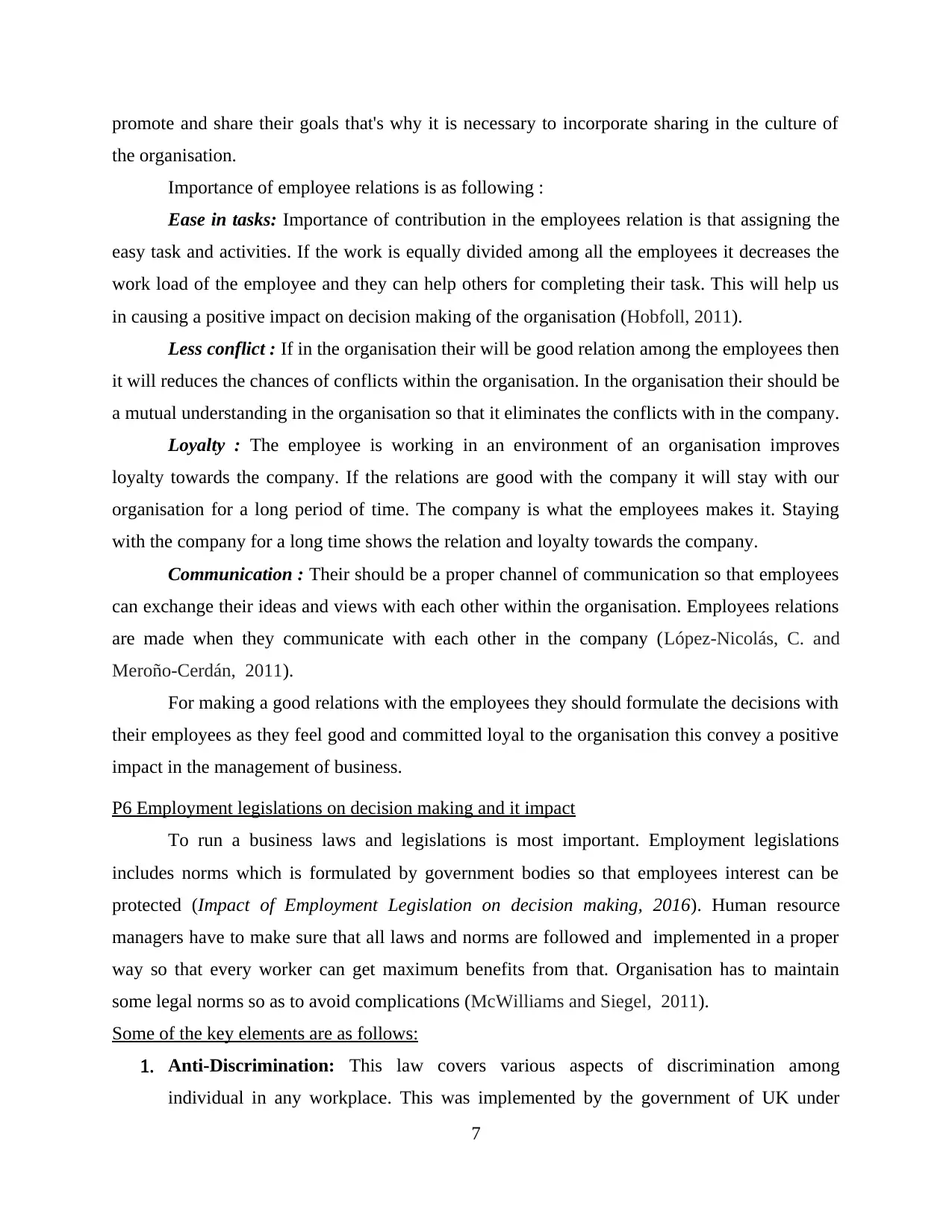
promote and share their goals that's why it is necessary to incorporate sharing in the culture of
the organisation.
Importance of employee relations is as following :
Ease in tasks: Importance of contribution in the employees relation is that assigning the
easy task and activities. If the work is equally divided among all the employees it decreases the
work load of the employee and they can help others for completing their task. This will help us
in causing a positive impact on decision making of the organisation (Hobfoll, 2011).
Less conflict : If in the organisation their will be good relation among the employees then
it will reduces the chances of conflicts within the organisation. In the organisation their should be
a mutual understanding in the organisation so that it eliminates the conflicts with in the company.
Loyalty : The employee is working in an environment of an organisation improves
loyalty towards the company. If the relations are good with the company it will stay with our
organisation for a long period of time. The company is what the employees makes it. Staying
with the company for a long time shows the relation and loyalty towards the company.
Communication : Their should be a proper channel of communication so that employees
can exchange their ideas and views with each other within the organisation. Employees relations
are made when they communicate with each other in the company (López-Nicolás, C. and
Meroño-Cerdán, 2011).
For making a good relations with the employees they should formulate the decisions with
their employees as they feel good and committed loyal to the organisation this convey a positive
impact in the management of business.
P6 Employment legislations on decision making and it impact
To run a business laws and legislations is most important. Employment legislations
includes norms which is formulated by government bodies so that employees interest can be
protected (Impact of Employment Legislation on decision making, 2016). Human resource
managers have to make sure that all laws and norms are followed and implemented in a proper
way so that every worker can get maximum benefits from that. Organisation has to maintain
some legal norms so as to avoid complications (McWilliams and Siegel, 2011).
Some of the key elements are as follows:
1. Anti-Discrimination: This law covers various aspects of discrimination among
individual in any workplace. This was implemented by the government of UK under
7
the organisation.
Importance of employee relations is as following :
Ease in tasks: Importance of contribution in the employees relation is that assigning the
easy task and activities. If the work is equally divided among all the employees it decreases the
work load of the employee and they can help others for completing their task. This will help us
in causing a positive impact on decision making of the organisation (Hobfoll, 2011).
Less conflict : If in the organisation their will be good relation among the employees then
it will reduces the chances of conflicts within the organisation. In the organisation their should be
a mutual understanding in the organisation so that it eliminates the conflicts with in the company.
Loyalty : The employee is working in an environment of an organisation improves
loyalty towards the company. If the relations are good with the company it will stay with our
organisation for a long period of time. The company is what the employees makes it. Staying
with the company for a long time shows the relation and loyalty towards the company.
Communication : Their should be a proper channel of communication so that employees
can exchange their ideas and views with each other within the organisation. Employees relations
are made when they communicate with each other in the company (López-Nicolás, C. and
Meroño-Cerdán, 2011).
For making a good relations with the employees they should formulate the decisions with
their employees as they feel good and committed loyal to the organisation this convey a positive
impact in the management of business.
P6 Employment legislations on decision making and it impact
To run a business laws and legislations is most important. Employment legislations
includes norms which is formulated by government bodies so that employees interest can be
protected (Impact of Employment Legislation on decision making, 2016). Human resource
managers have to make sure that all laws and norms are followed and implemented in a proper
way so that every worker can get maximum benefits from that. Organisation has to maintain
some legal norms so as to avoid complications (McWilliams and Siegel, 2011).
Some of the key elements are as follows:
1. Anti-Discrimination: This law covers various aspects of discrimination among
individual in any workplace. This was implemented by the government of UK under
7
⊘ This is a preview!⊘
Do you want full access?
Subscribe today to unlock all pages.

Trusted by 1+ million students worldwide
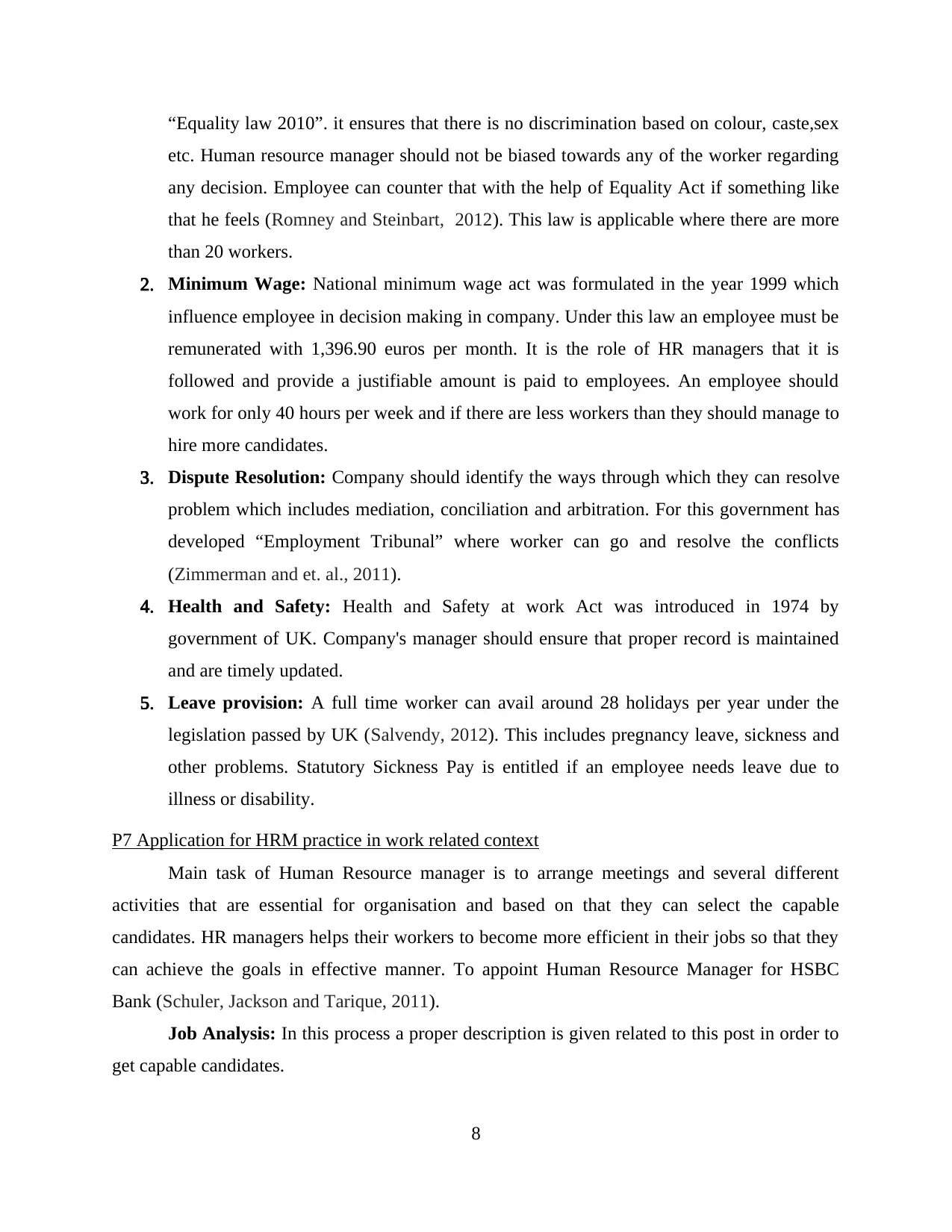
“Equality law 2010”. it ensures that there is no discrimination based on colour, caste,sex
etc. Human resource manager should not be biased towards any of the worker regarding
any decision. Employee can counter that with the help of Equality Act if something like
that he feels (Romney and Steinbart, 2012). This law is applicable where there are more
than 20 workers.
2. Minimum Wage: National minimum wage act was formulated in the year 1999 which
influence employee in decision making in company. Under this law an employee must be
remunerated with 1,396.90 euros per month. It is the role of HR managers that it is
followed and provide a justifiable amount is paid to employees. An employee should
work for only 40 hours per week and if there are less workers than they should manage to
hire more candidates.
3. Dispute Resolution: Company should identify the ways through which they can resolve
problem which includes mediation, conciliation and arbitration. For this government has
developed “Employment Tribunal” where worker can go and resolve the conflicts
(Zimmerman and et. al., 2011).
4. Health and Safety: Health and Safety at work Act was introduced in 1974 by
government of UK. Company's manager should ensure that proper record is maintained
and are timely updated.
5. Leave provision: A full time worker can avail around 28 holidays per year under the
legislation passed by UK (Salvendy, 2012). This includes pregnancy leave, sickness and
other problems. Statutory Sickness Pay is entitled if an employee needs leave due to
illness or disability.
P7 Application for HRM practice in work related context
Main task of Human Resource manager is to arrange meetings and several different
activities that are essential for organisation and based on that they can select the capable
candidates. HR managers helps their workers to become more efficient in their jobs so that they
can achieve the goals in effective manner. To appoint Human Resource Manager for HSBC
Bank (Schuler, Jackson and Tarique, 2011).
Job Analysis: In this process a proper description is given related to this post in order to
get capable candidates.
8
etc. Human resource manager should not be biased towards any of the worker regarding
any decision. Employee can counter that with the help of Equality Act if something like
that he feels (Romney and Steinbart, 2012). This law is applicable where there are more
than 20 workers.
2. Minimum Wage: National minimum wage act was formulated in the year 1999 which
influence employee in decision making in company. Under this law an employee must be
remunerated with 1,396.90 euros per month. It is the role of HR managers that it is
followed and provide a justifiable amount is paid to employees. An employee should
work for only 40 hours per week and if there are less workers than they should manage to
hire more candidates.
3. Dispute Resolution: Company should identify the ways through which they can resolve
problem which includes mediation, conciliation and arbitration. For this government has
developed “Employment Tribunal” where worker can go and resolve the conflicts
(Zimmerman and et. al., 2011).
4. Health and Safety: Health and Safety at work Act was introduced in 1974 by
government of UK. Company's manager should ensure that proper record is maintained
and are timely updated.
5. Leave provision: A full time worker can avail around 28 holidays per year under the
legislation passed by UK (Salvendy, 2012). This includes pregnancy leave, sickness and
other problems. Statutory Sickness Pay is entitled if an employee needs leave due to
illness or disability.
P7 Application for HRM practice in work related context
Main task of Human Resource manager is to arrange meetings and several different
activities that are essential for organisation and based on that they can select the capable
candidates. HR managers helps their workers to become more efficient in their jobs so that they
can achieve the goals in effective manner. To appoint Human Resource Manager for HSBC
Bank (Schuler, Jackson and Tarique, 2011).
Job Analysis: In this process a proper description is given related to this post in order to
get capable candidates.
8
Paraphrase This Document
Need a fresh take? Get an instant paraphrase of this document with our AI Paraphraser
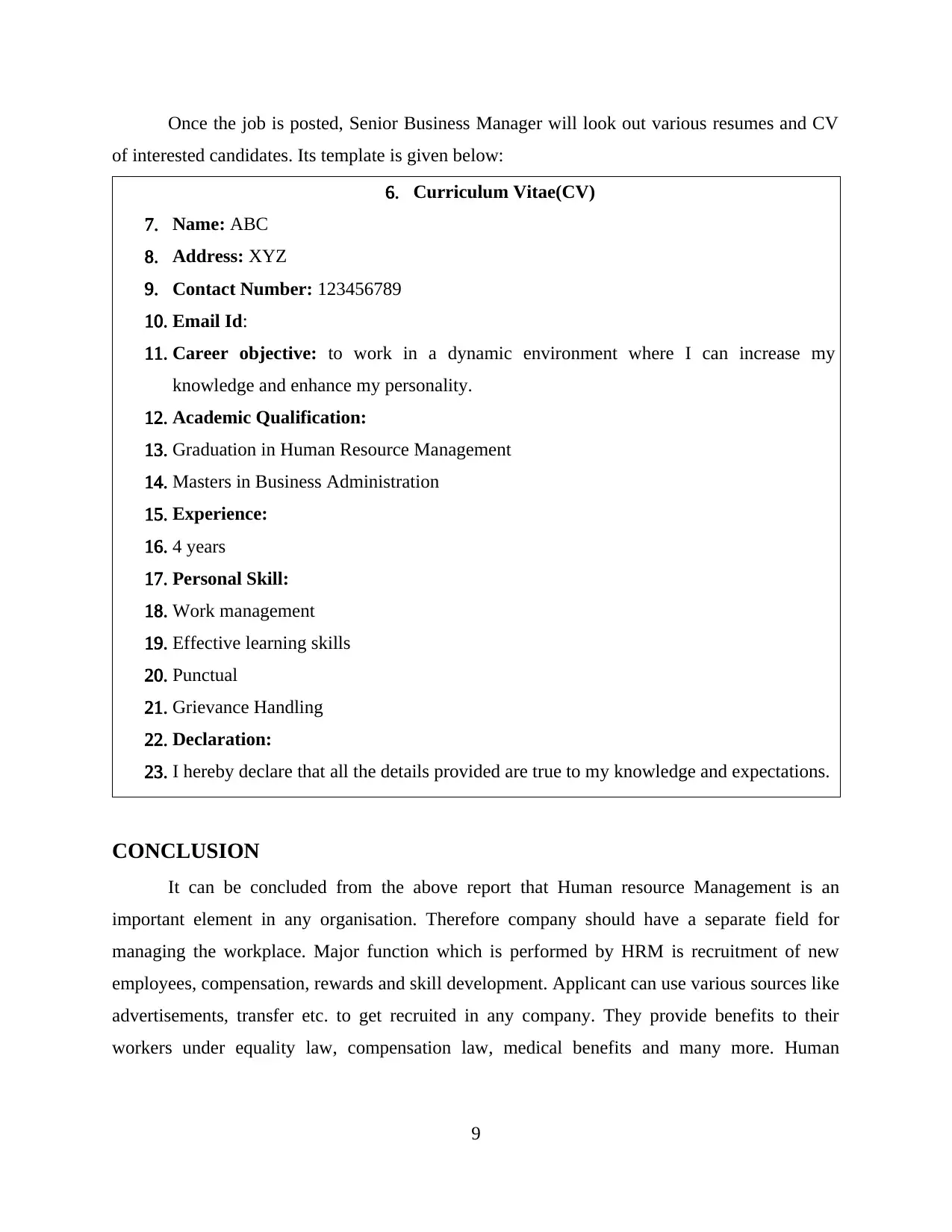
Once the job is posted, Senior Business Manager will look out various resumes and CV
of interested candidates. Its template is given below:
6. Curriculum Vitae(CV)
7. Name: ABC
8. Address: XYZ
9. Contact Number: 123456789
10. Email Id:
11. Career objective: to work in a dynamic environment where I can increase my
knowledge and enhance my personality.
12. Academic Qualification:
13. Graduation in Human Resource Management
14. Masters in Business Administration
15. Experience:
16. 4 years
17. Personal Skill:
18. Work management
19. Effective learning skills
20. Punctual
21. Grievance Handling
22. Declaration:
23. I hereby declare that all the details provided are true to my knowledge and expectations.
CONCLUSION
It can be concluded from the above report that Human resource Management is an
important element in any organisation. Therefore company should have a separate field for
managing the workplace. Major function which is performed by HRM is recruitment of new
employees, compensation, rewards and skill development. Applicant can use various sources like
advertisements, transfer etc. to get recruited in any company. They provide benefits to their
workers under equality law, compensation law, medical benefits and many more. Human
9
of interested candidates. Its template is given below:
6. Curriculum Vitae(CV)
7. Name: ABC
8. Address: XYZ
9. Contact Number: 123456789
10. Email Id:
11. Career objective: to work in a dynamic environment where I can increase my
knowledge and enhance my personality.
12. Academic Qualification:
13. Graduation in Human Resource Management
14. Masters in Business Administration
15. Experience:
16. 4 years
17. Personal Skill:
18. Work management
19. Effective learning skills
20. Punctual
21. Grievance Handling
22. Declaration:
23. I hereby declare that all the details provided are true to my knowledge and expectations.
CONCLUSION
It can be concluded from the above report that Human resource Management is an
important element in any organisation. Therefore company should have a separate field for
managing the workplace. Major function which is performed by HRM is recruitment of new
employees, compensation, rewards and skill development. Applicant can use various sources like
advertisements, transfer etc. to get recruited in any company. They provide benefits to their
workers under equality law, compensation law, medical benefits and many more. Human
9
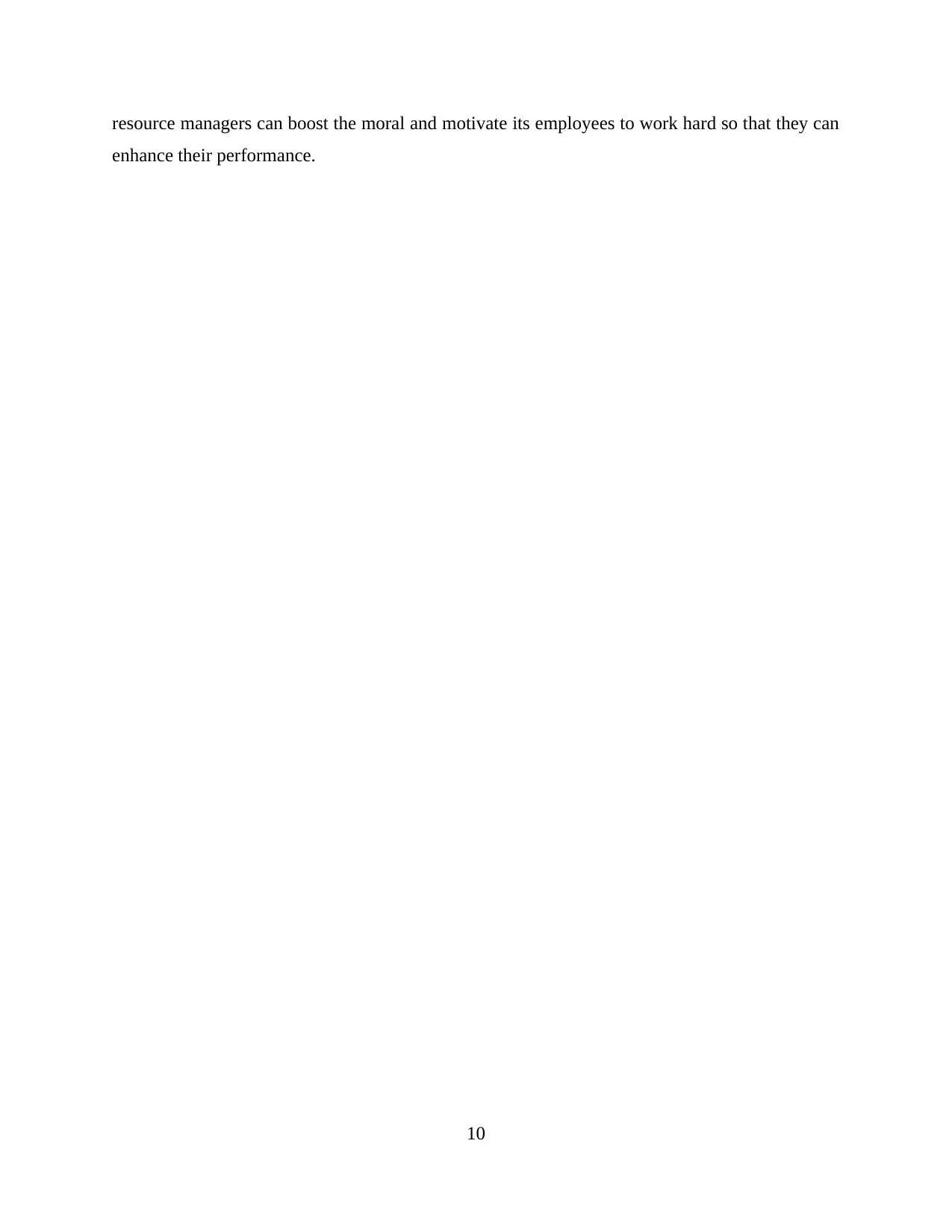
resource managers can boost the moral and motivate its employees to work hard so that they can
enhance their performance.
10
enhance their performance.
10
⊘ This is a preview!⊘
Do you want full access?
Subscribe today to unlock all pages.

Trusted by 1+ million students worldwide
1 out of 12
Related Documents
Your All-in-One AI-Powered Toolkit for Academic Success.
+13062052269
info@desklib.com
Available 24*7 on WhatsApp / Email
![[object Object]](/_next/static/media/star-bottom.7253800d.svg)
Unlock your academic potential
Copyright © 2020–2025 A2Z Services. All Rights Reserved. Developed and managed by ZUCOL.





